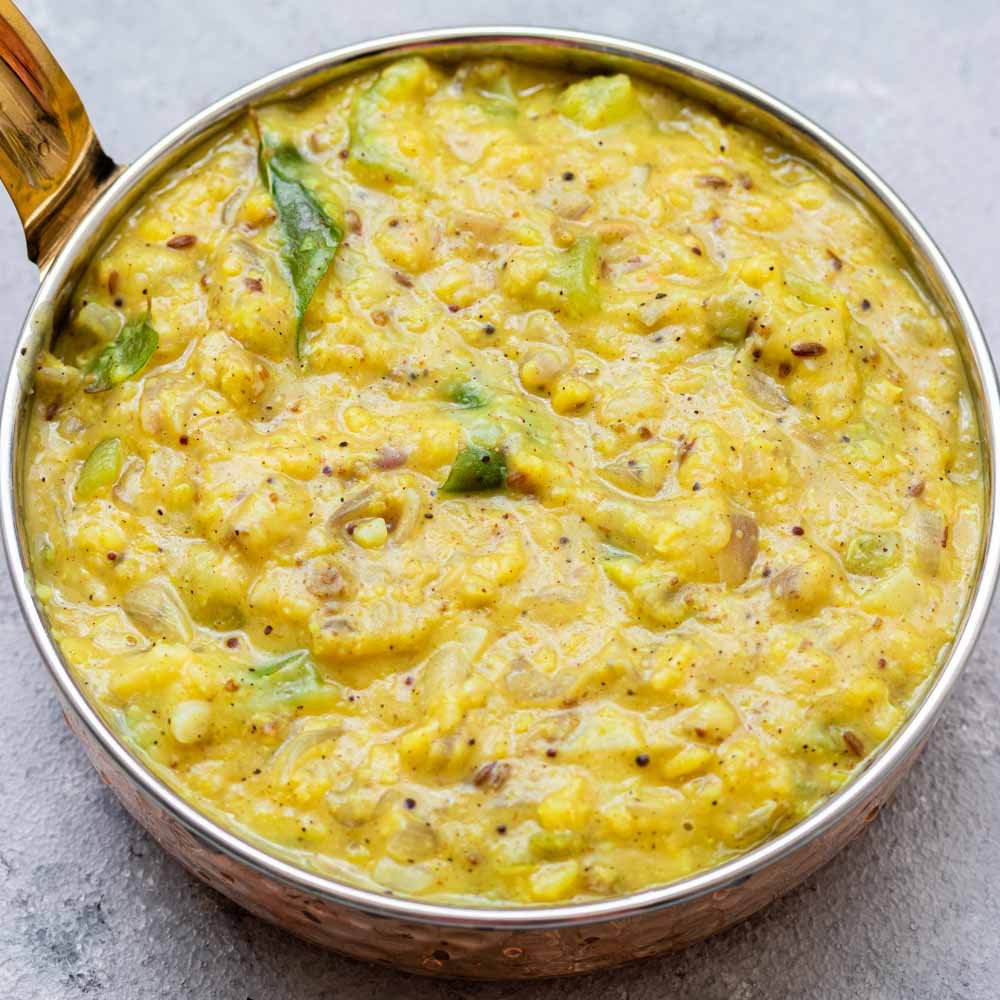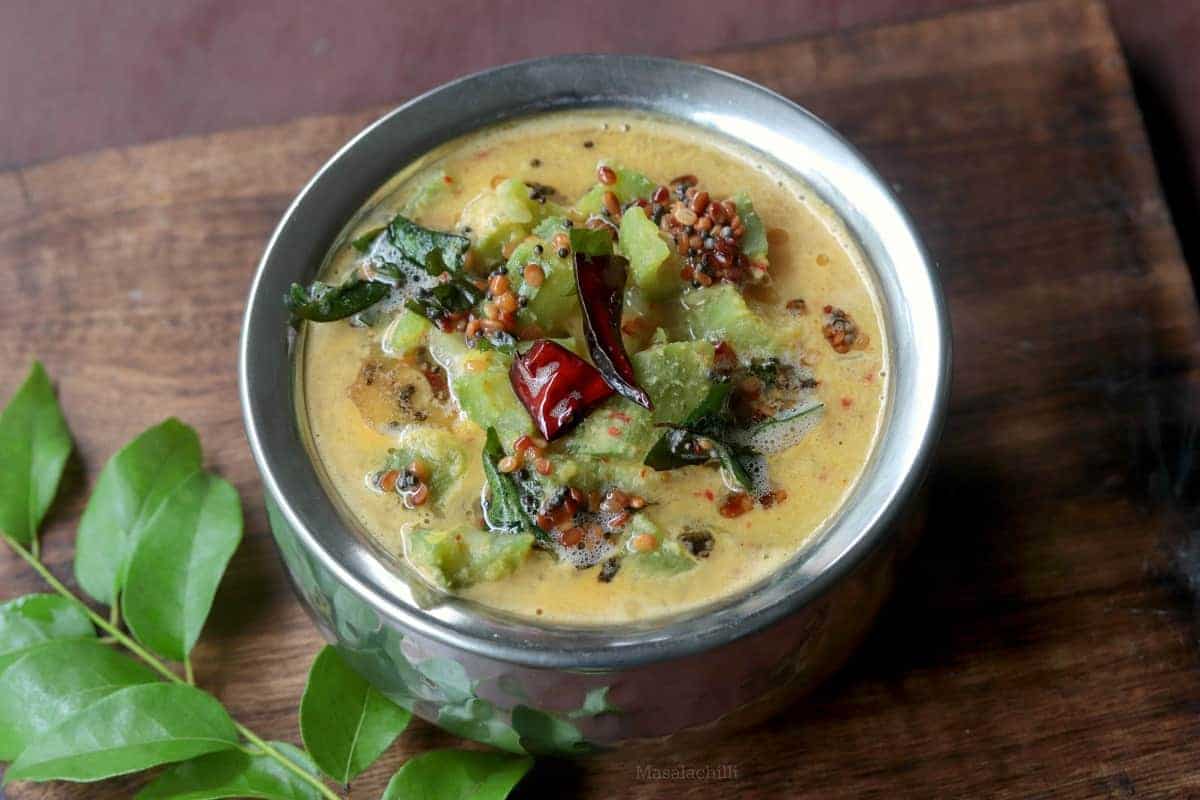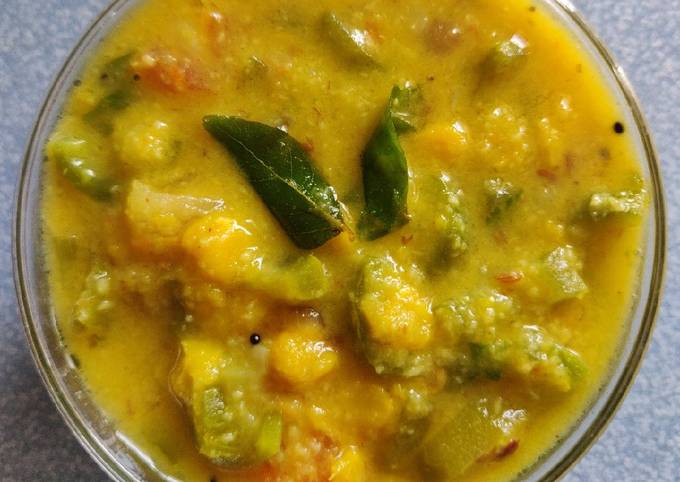Ridge Gourd Kootu is a comforting and healthful dish hailing from the South Indian cuisine, particularly common in Tamil Nadu. It’s a type of dal or stew that combines diced ridge gourd, also known as peerkangai in Tamil, with lentils and a blend of subtle spices. Kootu is often cherished for its simplicity and nutritious qualities, making it a staple in daily meals.
The ridge gourd is known for its mild flavor and sponge-like texture, which allows it to absorb the rich flavors of the spices. The gourd is peeled and cut into cubes or slices and cooked until soft. Meanwhile, lentils (commonly moong dal or toor dal) are boiled until they’re tender and then mixed with the cooked gourd.
In terms of spices, traditional Kootu recipes call for a harmonious mix that may include mustard seeds, cumin seeds, dried red chilies, curry leaves, and asafoetida (hing), often finished with a spoonful of grated coconut. These spices are tempered in oil and then added to the cooked lentils and gourd, infusing the dish with a fragrant aroma and complex flavors that range from nutty to mildly spicy.
Ridge Gourd Kootu Recipe


Ridge Gourd Kootu
Equipment
- 1 electric pressure cooker
- 1 pressure pan
Ingredients
- 4 cups cubed 2-inch pieces peeled ridge gourd
- 1/4 cup split yellow mung beans rinsed well and drained
- 11/2 cups water
- 1/4 teaspoon ground turmeric
- 1/2 cup shredded fresh coconut or frozen, thawed to room temperature
- 1 teaspoon cumin seeds
- 2 dried Guntur chiles
- 1 tablespoon finely chopped peeled fresh ginger
- 1 tablespoon coconut oil
- 1/2 teaspoon mustard seeds
- 1/2 teaspoon Bengal gram
- 1/2 teaspoon husked whole black lentils
- 1 curry leaf sprig
- 11/2 teaspoons salt
- 1 tablespoon fresh cilantro
Instructions
- In an electric pressure cooker, such as the Instant Pot®, or in a stovetop pressure cooker or pressure pan, combine the gourd, mung beans, water, and turmeric.
- For an electric pressure cooker, lock the lid into place and make sure the valve is in the Sealed position. Select Pressure Cook or Manual and set the time to 8 minutes on High Pressure. Let the pressure release naturally. For a stovetop pressure cooker, place it over medium heat and place the lid on. Ensure the sealing ring is on and place the weight on. Pressure cook until the cooker “whistles” 3 times. Let the pressure release naturally.
- While the gourd and mung beans cook, in a blender, combinethe coconut, cumin seeds, Guntur chiles, and ginger and grind into a coarse paste.
- In a large skillet or wok over medium heat, heat the coconut oil.
- Add the mustard seeds, Bengal gram, black lentils, and curry leaves. Cook until the mustard seeds begin to sputter, about 1 minute.
- Add the cooked gourd and mung beans and salt to the skillet. Simmer for 3 to 4 minutes.
- Add the ground coconut-spice paste and cilantro to the skillet and mix thoroughly. Bring it to a boil and then turn off the heat.
Notes
gourd, winter melon, or ash gourd.
Cooking Tips about Ridge Gourd Kootu

- Peel and Prep the Gourd: Start by peeling the ridge gourd to remove the slightly bitter skin. However, leave small streaks of skin for added texture and nutritional value.
- Use the Right Lentils: Ridge Gourd Kootu typically uses moong dal or toor dal. Make sure the lentils are properly rinsed and, if time allows, soak them for a short period to reduce cooking time.
- Evenly Cook Vegetables: Chop the ridge gourd into even cubes or slices so they cook uniformly. You don’t want some pieces to be mushy while others are undercooked.
- Sauté Spices: Temper the spices like mustard seeds, cumin seeds, dried red chilies, and curry leaves in oil until they crackle and release their aromas. This heightens the flavors in the Kootu.
- Cook Lentils Until Soft: Boil the lentils until they are tender before mixing with the cooked ridge gourd. Some prefer to pressure cook the lentils, which saves time.
- Avoid Overcooking: Once you combine the lentils and ridge gourd, cook just until everything is well incorporated. Overcooking can end up with a mushy texture.
- Adjust Consistency: The consistency of Kootu is somewhere between a dal and a dry curry. Add water sparingly to maintain this semi-thick texture, which should be perfect for mixing with rice.
- Finish with Coconut: A finishing touch of grated coconut adds a quintessential South Indian flavor. Fresh grated coconut is preferred for the best taste and texture.
- Check Seasoning: Remember to taste and adjust the seasoning. Ridge Gourd Kootu should have a balance of saltiness, mild spiciness, and a slight sweetness from the coconut.
- Garnish with Fresh Coriander: If desired, garnishing with coriander leaves can add a fresh burst of color and flavor to your Kootu before serving.
Serving suggestions about Ridge Gourd Kootu

- With Steamed Rice: The most classic way to enjoy Kootu is alongside hot steamed rice. It’s a traditional comfort food pairing in South India.
- As a Side Dish: Serve it as part of a South Indian thali, which includes various dishes such as rasam, sambar, dry vegetable curry (poriyal), and pappadum.
- With Flatbreads: Although not typical, Kootu can also be enjoyed with roti or chapati if you prefer a less rice-centric meal.
- Top with Ghee: For an added depth of flavor, a dollop of ghee (clarified butter) can be added on top of the Kootu when serving with rice.
- Accompanied by Pickles: A side of spicy Indian pickle can add a tangy kick to the subtle flavors of the Kootu.
- Include Raita: A yogurt-based raita with cucumber or pineapple can provide a cooling contrast to balance the warmth of the dish.
- As Part of a Meal Prep: The Kootu can easily be a part of your meal prep, stored in the fridge, and reheated for a comforting meal during the week.
- Sprinkle with Coriander: Garnishing with fresh coriander leaves before serving adds a burst of color and fresh flavor.
- Serve with Papad: Crispy papads (lentil crackers) are a lovely crunchy accompaniment to the creamy texture of Ridge Gourd Kootu.
- Enjoy with Sambar: For a more indulgent meal, serve it with Sambar. Both dishes can be mixed with rice for a fulfilling dining experience.
Top 5 FAQs about Ridge Gourd Kootu

- What type of lentils are used in making Ridge Gourd Kootu? Ridge Gourd Kootu commonly uses moong dal (split yellow lentils) or toor dal (split pigeon peas). These lentils are known for their soft texture and quick cooking time, which complement the ridge gourd well.
- Can I use another type of gourd instead of ridge gourd? Yes, while ridge gourd (peerkangai) is traditional, you can use other types of gourd such as bottle gourd (lauki) if ridge gourd is not available. However, the taste and texture might vary slightly from the classic Kootu.
- Is it necessary to peel the ridge gourd completely for the Kootu? It’s recommended to peel the ridge gourd but leave small streaks of skin for added texture and nutritional value. The skin can be slightly bitter, so peeling most of it helps achieve a better balance of flavor.
- Can Ridge Gourd Kootu be made without coconut for someone with allergies? Yes, the coconut can be omitted if one has an allergy or does not like the taste. The dish will lack the sweetness and texture provided by coconut but can still be enjoyable with the rest of the spices and ingredients.
- How can I store and reheat leftovers of Ridge Gourd Kootu? Leftover Ridge Gourd Kootu can be stored in an airtight container in the refrigerator for up to 2-3 days. Reheat on the stove over medium heat, adding a little water if necessary to adjust consistency, until thoroughly warmed through.
Ridge Gourd Kootu is an exemplary dish of South Indian cuisine, embodying the culinary philosophy of simplicity, nutrition, and flavor. Through the combination of tender-cooked ridge gourd, soft lentils, and a medley of beautifully tempered spices, it offers a soothing and balanced meal that satisfies both the palate and the soul.

Leave a Reply